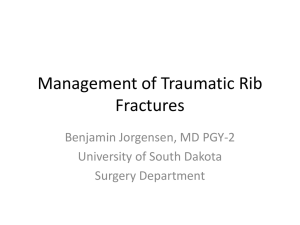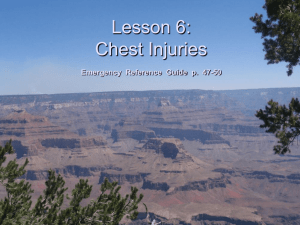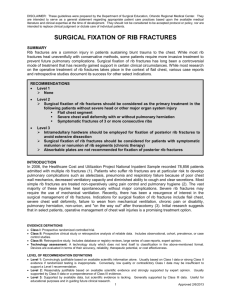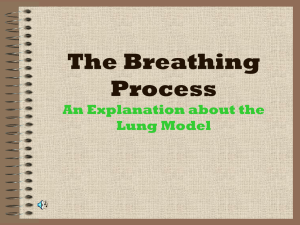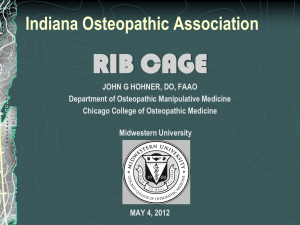Novel Treatments of Rib Fractures * Hype or Future?
advertisement
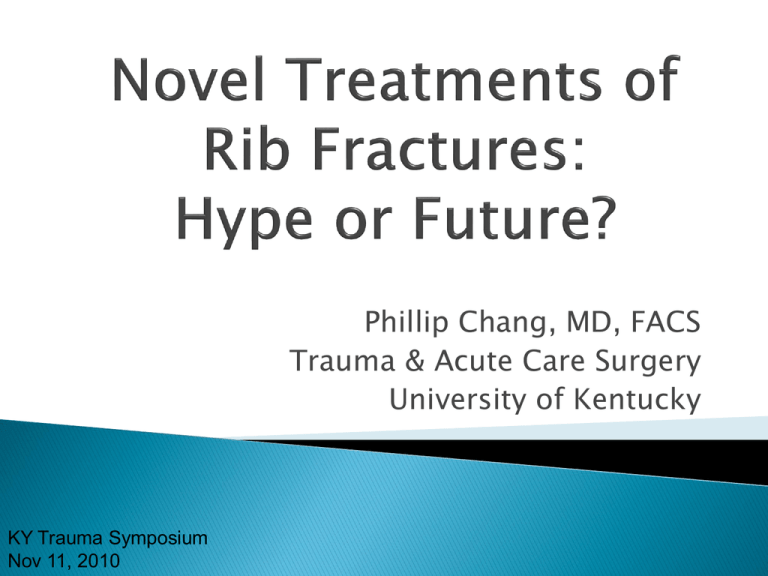
Phillip Chang, MD, FACS Trauma & Acute Care Surgery University of Kentucky KY Trauma Symposium Nov 11, 2010 Anatomy and Definition Review traditional therapies Review of the literature Discuss novel therapies UK Case example Finish on-time 10% of trauma patients have rib fractures under reported - up to 50% of fractures may be undetected radiographically Elderly (age ≥ 65) 20.1% mortality vs. 11.4% Number of ribs matter 1-4 rib fractures: 5.4% mortality ≥5 rib fractures: 8.9% mortality Associated pulmonary contusion thought to be underlying cause of long term dysfunction Rib Fractures in the Elderly: a marker of injury severity. Stawicki et al. Journal of American Geriatrics Society, 2004 TsO2 management of flail chest in trauma: Analysis of risk factors affecting outcome. Ali et al. ANZ Journal of Surgery, 2007 >3 adjacent ribs, fractured in at least two places Paradoxical respiration 75 per 50,000 patients per year 1-2 cases per month for each trauma center Pulmonary contusion is key problem Decreased compliance Increased shunting Decreased: HLO 33% Morbidity 20% Mortality: 0% Management of flail chest without mechanical ventilation. Trinkle JK et al. Annals Thoracic Surgery, 1975 Ventilation – perfusion mismatch ◦ APRV, CPAP (non intubated), prone Maintaining pulmonary toilet ◦ Physiotherapy, NT suctioning ◦ Timely tracheostomy Adequate fluid resuscitation ◦ Colloids? ◦ Hypertonic saline? Pain management Possible surgical fixation Operative chest wall stabilization in flail chest--outcomes of patients with or without pulmonary contusion. Voggenreiter et al. J Am. Coll Surg. 1998 Management of Flail Chest Miller et al. Can. Med. Ass. J. 1983 NSAID • Limited in renal dysfunction and/or history of peptic ulcer disease Oral Narcotics • Ileus • dependency IV narcotics (including IVPCA) • Sedation • Cough suppression • Respiratory depression/hypoxemia Rib taping/rib belts • Not shown to beneficial A randomized clinical trial of rib belts for simple fractures. Quick G. American journal of Emergency Medicine, 1990. Local rib blocks • Only lasts ~6 hours • Repeated injections may lead to toxicity • Upper ribs difficult Intrapleural infusion catheters • like a chest tube • Actual chest tube causes loss of anesthetics • Could clamp intermittently • Semi-recumbent position leads to dependent pooling of local anesthetics EAST practice guideline: • Level 1 “clinical application of pain management modalities to treatment of blunt thoracic trauma” Epidural analgesia is the optimal modality of pain relief for blunt chest wall injury and is the preferred technique after severe blunt thoracic trauma. • Level II “technical aspect” Combination of narcotic (fentanyl) & local (bupivicaine) is preferred Pain Management in Blunt Thoracic Trauma. EAST guideline. Journal of Trauma, 2005 Advantages Increased functional residual capacity (FRC), lung compliance, vital capacity Remain awake – pulmonary toilet Disadvantages relative contraindicated: • Spine fracture • High rib fractures • Sedated/intubated patients Cause hypotension Infection – rare Hematoma “high block” – respiratory insufficiency Narcotic component • Nausea/vomiting Advantages Does not require painful palpation of ribs Not limited by scapula No risk of spinal cord injury Can be used on sedated patients Hypotension rare Disadvantages Complications: ◦ Pneumothorax ◦ Vascular injury Lack of literature support Continuous Thoracic Paravertebral Infusion of Bupivacaine for Pain Management in Patients With Multiple Fractured Ribs* Karmakar et al. Chest. 2003 Feb Mayo clinic Randomized controlled trial 124 patients had catheters placed after thoracotomy ◦ 60 received bupivicaine ◦ 64 reveived placebo ◦ All had epidural catheter until POD#3 A randomized controlled trial of bupivacaine through intracostal catheters for pain management after thoracotomy Allen el al. Annals of Thoracic Surgery, 2009. India Prospective randomized 30 patients Unilateral rib fracture Epidural vs. TPVB Prospective, randomized comparison of continuous thoracic epidural and thoracic paravertebral infusion in patients with unilateral multiple fractured ribs – a pilot study Mohta et al. Journal of Trauma, 2009 Complications of prolonged ventilation ◦ Ventilator associated pneumonia ◦ Tracheal stenosis ◦ Ventilator associated lung injury ◦ pneumothorax Indicatons and Surgical Treatment of theTraumatic Flail Chest Syndrome: An original Technique. Sanchez-Lloret J. et al: Thorac. Cardiovasc. Surgeon. 1982. Treatment of flail chest with Judet’s struts. Menard et al. J Thoracic Cardiovascular Surgery, 1983 Survey 405 US surgeons (all from Level 1 and Teaching H.) ◦ 238 trauma surgeons ◦ 97 orthopedic surgeons ◦ 70 thoracic surgeons >1 Surgical indication ◦ Trauma: 82% ◦ Ortho: 66% ◦ Thoracic: 71% Knowledge on published randomized trials 16% TRS, 3%OS, and 8%THS Surveyed opinion of American trauma, Orthopedic, and Thoracic surgeons on Rib and Sternal Fracture repair. Mayberry et al. Journal of Trauma, 2009 External fixation with traction - early 20th century Trauma.org 64 patients with primarily flail chest and pulmonary contusion over 10 years in UAE Fixation (n=26) Ventilator (n=38) Vent (days) 1.3 (80%) 3.9 (total) after fixation 15 Trach 11% 37% VAP 15% 50% Mortality 8% 29% ICU LOS 9 days 21 days Management of flail chest injury: Internal fixation versus endotracheal intubation and ventilation Ahmed et al. Journal of Thoracic and Cardiovascular Surgery, 1995 Medical College of Wisconsin 1996-2000 Matched, casecontrolled study 30 patients each Struts used after thoracotomy Rib fracture stabilization in patients sustaining blunt chest trauma Nirula et al. American Surgeon, 2006 Berne, Switzerland Prospective evaluation Surg. Stabilization of flail chest 1990-1999 66 patients ◦ Median time to fixation: 2.8 days ◦ Extubation 7d. post-op: 85% ◦ 30 day Mortality 11% (ARDS) Significant difference at 6 months of predicted vs. recorded TLC Line = 85% of value of the predicted TLC Pulmonary function testing after operative stabilisation of the chest wall for Flail chest Lardinois et al. European Journal of Cardio-thoracic Surgery 2001 37 consecutive flail chest patients ◦ Randomization after 5 days on vent ◦ 18 rib fixation ◦ 19 internal pneumatic Surgical Stabilization of Internal Pneumatic Stabilization? A Prospective Randomized Study of Management of Severe Flail Chest Patients. Tanakaet al. Journal of Trauma, 2002 Surgical (n=18) “internal” (n=19) Pneumonia, day 7 5% 16% NS Pneumonia, day 21 22% 90% <.05 Ventilator days, total (post-op) 10.8 (2.5) 18.3 <.05 Tracheostomy, day 7 0 5/19 NS Tracheostomy, day 21 3/18 15/19 <.05 Total ICU stay (postop) 16.5 (9.2) 26.8 <.05 Medical expense $13,455 $23,423 <0.5 Forced expiratory functional capacity, 0-12 months Paravertebral intercostal nerve block Rib fixation for pain Rib fixation for vent failure Ventilator Epidural P.O. Pain Rib fixation for flail Surgical Stabilization of Severe Flail Chest Casali, et al. CTSnet, 2005 Chest trauma with rib fx Single / few rib fx Unilateral rib series fx Adequate pain med. PO vs i.v Resp. training VC ≥800 No flail chest not intubated VC ≥800 & Adequate pain OnQ Pump VC< 800 Pain score >7 COPD Patient ORIF only (ant./lat.fx) Bilateral rib series fx Flail chest Intubated or not ORIF only (ant./lat.fx.) Not true flail chest Intubated & not ORIF only ant./lat. for displaced fx Consider OnQ Pump for 72 hrs post op True flail chest with or without sternum fx. Intubated & not Bilateral ORIF only ant./lat. + sternum ORIF if displaced OnQ Pump for Contralateral Side VC= Vital Capacity tested on incentive spirometer Hasenboehler Suggested SGB Trauma protocol 2010 Raminder et al World J Surg (2009) 33:14–22 Pulmonary function testing after operative stabilisation of the chest wall for Flail chest Lardinois et al. European Journal of Cardio-thoracic Surgery 2001 Precontoured Titanium Locking Plates Precontoured plates 4 plates each side Right = Rose-red Left = Light blue Profile 1.5mm 15, 16, 17 and 18 holes Universal plate 8 holes Gold 3 Widths ◦ ◦ ◦ Small – 3 mm Medium – 4 mm Large – 5 mm Length 92.5 mm (75 mm in IM canal) Ideal for Posterior Fractures Minimally invasive One screw to secure splint 64 yo male, MVC Injuries: Rib fractures: left 4-10 with 4-7 flail right 2nd& 5th Left hemothorax Manubrium fx Right acetabular fx Left fibula fx ICU not intubated GCS = 15 / ISS 25 COPD TV Max 300ml preop. OR on HD #3 Extubation on HD #4 (1 days vent.) TV 900ml postop. Discharged 16 days later to rehab Pulmonary toilet, pain control are key Local paravertebral anesthesia can be an adjunct Rib fixation Consider within 5 days of injury Liberal use of 3-D CT scan images Locking plates Elderly patients with brittle bones can be done Every fracture does not need to be fixed Thoracotomy and double-lumen intubation not necessary
